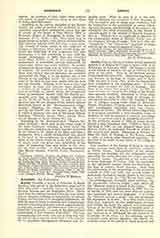

Acosta, JOSE DE, the son of well-to-do and respected parents, b. at Medina del Campo in Spain, 1540; d. at Salamanca, February 15, 1600. He became a novice in the Society of Jesus at the age of thirteen at the place of his birth. Four of his brothers successively joined the same order. Before leaving Spain he was lecturer in theology at Ocana, and in April, 1569, was sent to Lima, Peru, where the Jesuits had been established in the preceding year. At Lima Acosta again occupied the chair of theology. His fame as an orator had preceded him. In 1571 he went to Cuzco as visitor of the college of the Jesuits then recently founded. Returning to Lima three years later, to again fill the chair of theology, he was elected provincial in 1576. He founded a number of colleges, among them those of Arequipa, Potosi, Chuquisaca, Panama, and La Paz, but met with considerable opposition from the viceroy, Francisco de Toledo. His official duties obliged him to investigate personally a very extensive range of territory, so that he acquired a practical knowledge of the vast province and of its aboriginal inhabitants. At the provincial council of 1582, at Lima, Acosta played a very important part. Called to Spain by the king in 1585, he was detained three years in Mexico, where he dedicated himself to studies of the country and people. Returning to Europe, he filled the chair of theology at the Roman college in 1594, as well as other important positions. At the time of his death he was rector of the college at Salamanca.
Few members of the Society of Jesus in the sixteenth century have been so uniformly eulogized as Father Acosta. Independently of his private character, his learning and the philosophic spirit pervading his works attracted the widest attention in learned circles. Translations of his works exist in many languages of Europe, while the naturalists of the eighteenth century praise his knowledge of the flora of western South America. Aside from his publications of the proceedings of the provincial councils of 1567 and 1583, and several works of exclusively theological import, Acosta is best known as a writer through the “De Natura Novi Orbis,” “De promulgatione Evangelii apud barbaros, sive De procuranda Indorum salute”, and, above all, the “Historia natural y moral de las Indias.” The first two appeared at Salamanca, in 1588; the last at Seville, in 1590, and was soon after its publication translated into various languages. It is chiefly the “Historia natural y moral” that has established the reputation of Acosta. In a form more concise than that employed by his predecessors, Gomara and Oviedo, he treats the natural and philosophic history of the New World from a broader point of view. Much of what he says is of necessity erroneous, because it is influenced by the standard of knowledge of his time; but his criticisms are remarkable, while always dignified. He reflects the scientific errors of the period in which he lived, but with hints at a more advanced understanding. As far as the work of the Church among the Indians is concerned, the “De procuranda Indorum salute” is perhaps more valuable than the later “Historia,” because it shows the standpoint from which efforts at civilizing the aborigines should be undertaken. That standpoint indicates no common perception of the true nature of the Indian, and of the methods of approaching him for his own benefit.
AD. F. BANDELIER

